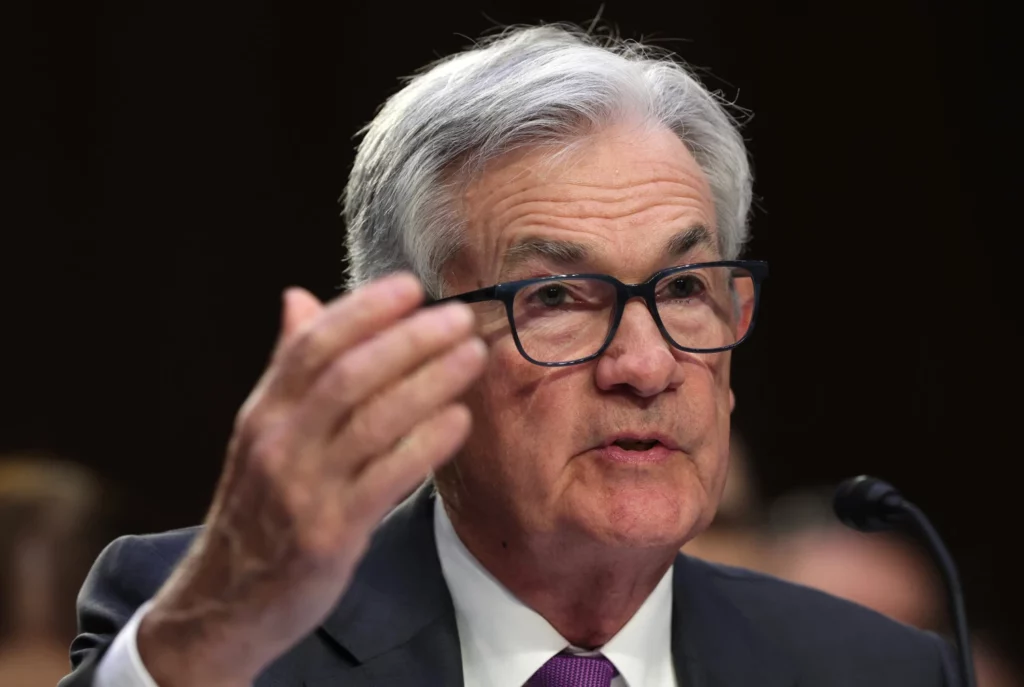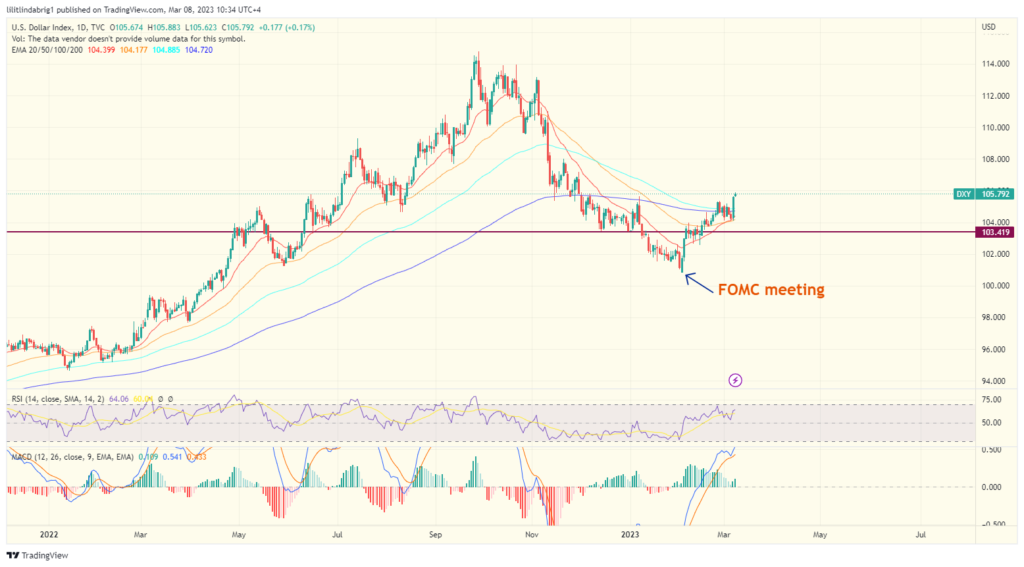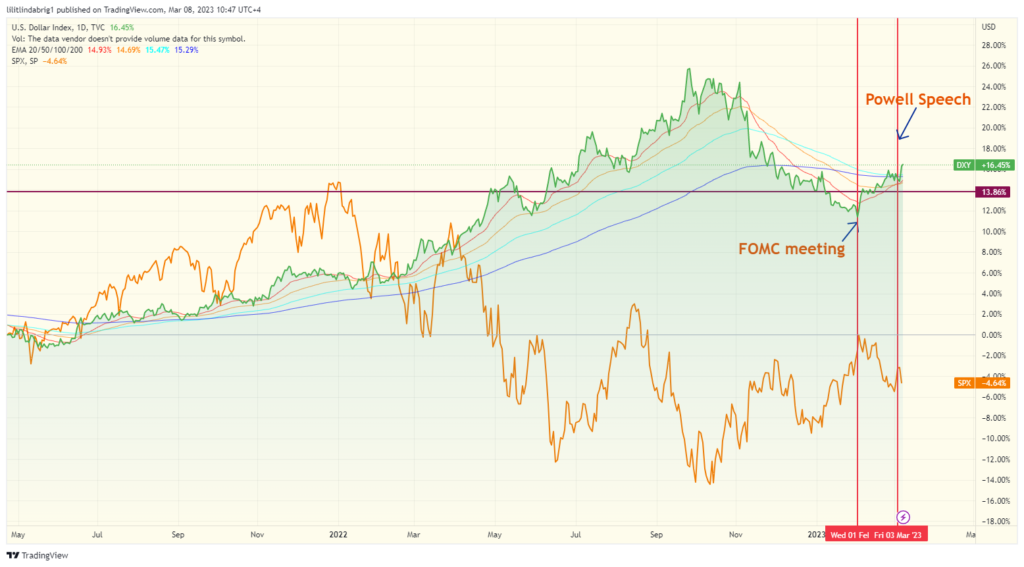Key Takeaways:
- Fed's Jerome Powell addressed the Congress, delivering an unexpectedly hawkish stance - more and steeper interest rate hikes ahead
- the dollar index rises on the back of tumbling stocks.
- Treasury yields dip after the Powell speech, inversion raises recession fears

YEREVAN (CoinChapter.com) – Fed Chair Jerome Powell is likely to raise interest rates higher and sharper than expected. The official addressed Congress in a Q&A session with senators on Mar 7-8, delivering a hawkish testimony, which pumped the dollar index higher as the US stocks plummeted, and the treasury yield inversion hit its steepest mark in more than four decades. Recession fears rekindled.
Powell speech raises the dollar index
During the session, US Senator and Chair of the meeting Sherrod Brown addressed Powell, underscoring the fact that runaway inflation is a complex issue, and a rise in interest rates is only a “blunt tool” in efforts to curb it. However, he also blamed large corporations for raising profit margins beyond their increased costs, driving inflation higher.
Before addressing the monetary policy, Powell commented on the higher-than-expected inflation data from January. He asserted that the “supply chain bottlenecks have eased, and energy prices declined,” somewhat cooling the inflation off. However, the “pressure remains high,”
That said, there’s little sign of inflation easing in the category of core services, excluding housing. A category that accounts for more than half of core consumer expenditures. To restore price stability we’ll have to see lower inflation in this sector, and there will very likely be some softening in the labor market conditions.
commented Powell.
He then proceeded to discuss the monetary policy that Fed will implement in its efforts to bring inflation down to the 2% goal. The lawmakers have a “long way to go, and it is likely to be bumpy,” said the Chair.
We continue to anticipate that ongoing increases in the target range for the federal funds rate will be appropriate in order to attain a stance of monetary policy that is sufficiently restrictive to return inflation to 2 percent over time
continued Powell.
Also read: US Sees Lower Recruitment Ads in Latest Challenge to Jobs Market — Brace for Recession?
As the Chair delivered his hawkish stance, the dollar index (DXY) shot up nearly 2%, paring its weekly losses.
Dollar index jumps 2% after the speech.
In detail, the dollar index measures the greenback’s strength relative to the basket of 6 foreign currencies. Thus, when the Federal Reserve implements interest rate hikes, the dollar index typically picks up accordingly, commanding the investors’ increased interest.
Before the speech on Mar 7, the Fed’s decisions appeared more dovish. The lawmakers planned increases by 25 basis points, which is a dovish shift compared to Q1-Q3, 2022. Nonetheless, the DXY has been on an upward trajectory since the Federal Open Market Committee (FOMC) meeting on Feb 2. As a result, the index reached 105 on Mar 8, the highest reading since early Dec 2022.

While hawkish policies have a reviving effect on the DXY, they tend to tumble the risk-on market as investors turn to the greenback for profit, pulling away from stocks.
Also read: US new home sales jump to a near-year high – what does it mean?
US stocks tumble, rekindling recession fears.
The US stock index S&P500 (SPX) tumbled over 2% since the Powell speech on Mar 7. The chart below demonstrates the inverse correlation between the dollar index and the S&P500 index, underscoring the effect of interest rate hikes.

While the stock market partially pared its losses, rising nearly 5% year-to-date, the US economy could still plunge into a recession. In detail, the Fed has a tough job of balancing a thin line between runaway inflation and recession. And some experts believe they might have been late recognizing the problem.
Quincy Krosby, the chief global strategist for LPL Financial, agreed that the Fed still has a long way to go, recalling that “it took them a long time to acknowledge that inflation was stickier than they initially assessed.”
This is not to criticize them but to understand: They do not know more about inflation than the average consumer. That’s important. It’s just that it’s their job to know. And that’s where the criticism comes in.
he added.
Tim Ghriskey, the senior portfolio strategist at Ingalls & Snyder in New York, also argued that Fed’s actions could potentially drive the US economy into a recession. “The world is concerned that the Fed hikes rates so much and so long that the U.S. could head into recession,” he said.
Benson Suet, Business Development & Strategic Partnership at Coinstore.com, agreed, underscoring the importance of the upcoming inflation report on Mar 14.
For a risk-on market, inflation has to come down progressively. The market will be sensitive to the upcoming CPI report. If inflation is sticky at 6%, it means Fed has to hike higher interest rates to bring the inflation down.
he told CoinChapter.
Also read: FOMC meeting minutes released – what to expect from Bitcoin?
Treasury yield inversion at its steepest mark in 4 decades
Additionally, the Benchmark Treasury yields dipped after the Powell speech, and the inversion between 2-year and 10-year Treasury yields steepened, which is an early sign of a potential recession. It was last wider in 1981.
As noted by Reuters, the benchmark 10-year notes last rose 4/32 in price to yield 3.9696%, from 3.983% late on Mar 6. The 30-year bond last rose 18/32 in price to yield 3.8794%, from 3.912% late on Mar 6.
In detail, the bond market is a crucial indicator for identifying a looming recession. An inverted yield curve is “rare but strongly suggestive” of a severe economic slowdown. Historically, the yield curve has inverted prior to each of the ten most recent recessions, so this metric—while not a guarantee of future economic behavior—has a strong track record.
In April 2022, Bloomberg experts predicted a recession by the end of 2023 based on the yield curve inversion.

Conclusion
Jerome Powell addressed the Congress members, displaying a more hawkish approach than the market expected. Thus, the dollar index rose nearly 2% after the Powell speech and will likely continue to rise, given the upcoming interest rate hikes. Meanwhile, the stock market will likely move in the opposite direction, paring its recent gains, as the economy faces a possible recession.
The inversion of the treasury yields curve is another indicator of more headwinds ahead. The treasury yield inversion hit its steepest mark in more than four decades, which is a historically accurate gouge of an incoming recession. Read more about the US economy here, and don’t miss out on the ever-changing market.


